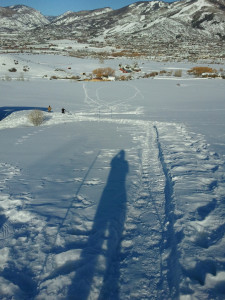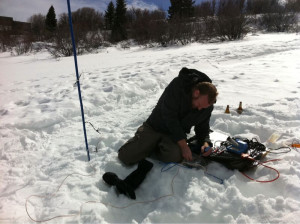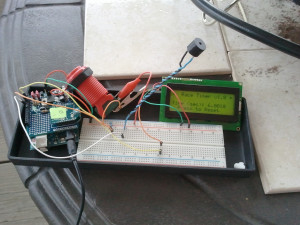Soldering in the Snow
Some friends of mine have a house in the mountains in Steamboat Springs, Colorado. In the winter they dig a luge track in the (many feet of) snow in their yard and have timed sled races to see who can make it down the fastest. They call it the Mario Cup. I went out there last week with my buddy Mario (a member at Artisan’s Asylum and the namesake of the race) and we made some improvements to the system. Details below.
As you can see, the luge is several hundred feet long and on the side of a mountain, so it’s tough for a person with a stopwatch to know when to start and stop the time. Here I am testing the track before we had finished it; at the end, I’m a tiny little dot in the snow.
Mario and his girlfriend also helped calibrate the track.
Recently, the competition has become fierce and the accuracy of a stopwatch-wielding human isn’t enough to conclusively pick a winner. So we automated it.
We designed a system so a “race official” would start the clock by hitting a button on a controller, which would sound a loud countdown of beeps and then start the clock. The luger would take off from the start line down the track. Arduinos hooked to sensors would detect when the luger passed the start, midpoint, and finish lines. The arduinos were also connected to Xbee radios to communicate the time at which the racer passed by.
It took a while to sort out which sensor would work best. We tinkered around with tilt sensors, photointerrupters, Hall effect sensors, and proximity sensors. We ended up with plain old photoresistors wrapped in plastic wrap, sealed with tape, and buried in snow under an upside-down disposable plastic food container. That way, the luger would slide right over the sensor, block the bright white light coming off the snow, and trigger the arduino to note the time and send it back to the controller. Here we are setting up the sensors and tuning them in fast forward.
And here I am, soldering up voltage dividers in the snow. Potentiometers are difficult to find in Steamboat, but the snow keeps beer cold while you resolder new resistors, so I’m calling it a wash.
Finally, we got the sensors tuned just so.
The timing data was sent by radio back to the controller, which showed the time on an LCD display.
Now truth and justice will prevail in the Steamboat Backyard Luge Association races. More information can be found here: http://mariocup.tumblr.com/
Next steps for the project include adding in two sensors at the start, midpoint, and finish so we can know the luger’s speed at each point, and adding in some fancy blinding-bright luxeon 1-watt LEDs to give the luger a proper starting signal like a christmas tree at a drag race. Any excuse to go back will do.



[…] Their system consists of two parts: A countdown timer/control unit at the starting line to kick off the race, and a sensor at the finishing line to end the race. A pair of Arduinos with attached xBee radios were used for communication, and a photocell buried under the snow detected when riders passed over it. [via NYC Resistor] […]
[…] for communication, and a photocell buried under the snow detected when riders passed over it. [via NYC Resistor] Address: […]
[…] for communication, and a photocell buried under the snow detected when riders passed over it. [via NYC Resistor] Article source: […]
[…] In Colorado, amateur luge competitions are serious business. […]
[…] In Colorado, amateur luge competitions are serious business. […]